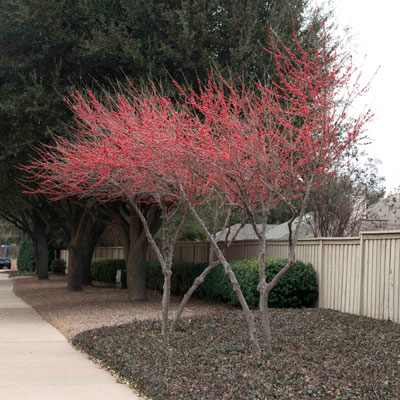Warren’s Red Possumhaw Holly

Photo: Possumhaw hollies were planted by the developer of Stonebridge Ranch in McKinney 25 years ago. They are beautiful mature plants now.
At the risk of wearing you out telling you about my childhood in College Station – back when horned toads roamed the Earth – I’m going to go back there to that fabulous big, old possumhaw holly that grew on the south side of North Avenue. I was a kindergartner when I first saw it, but it sticks in my mind like the first time I saw Mickey Mantle in Yankee Stadium in real life.
Jump ahead 24 years. I’d finished at A&M Consolidated, attended Texas A&M, transferred to Ohio State for my undergraduate degree in floriculture, started a Master’s at Colorado State, got engaged therefore moved back to Ohio State and finished my Master’s, got married, taught in Shelby, Ohio, for two years, moved to Dallas as County Horticulturist and then, in 1972, moved to the Texas A&M Center on Coit Road in Dallas as area horticulturist serving 17 counties.
That was a lot of traveling, and wouldn’t you have thought I’d have learned a lot more about this plant by then. But no. It just didn’t impact me as a great landscaping option until my friend Benny Simpson planted one at the TAMU Dallas Center – basically right outside my window, so I could look at it every day as my “message from Benny.”
His plant seemed a little more special than the ones I’d seen as a kid. Its fruit was larger, and it was a brighter tomato-red. And that plant didn’t establish clumps via rootsprouts like the native one on land we had bought for our future home site outside McKinney had done. This was truly a superior selection. Benny told me it was Warren’s Red from the Warren’s Nursery, apparently closed years earlier, in Oklahoma City.
Here’s What to Love About Possumhaw Hollies…
• Scientific name (for those who like to remember them): Ilex decidua. Perfect. Even I can see how they came up with that one.
• Mature height and width: 18 ft. tall by 15 ft. wide. (Think of a tree-form crape myrtle.)
• Foliage: Deciduous, dropping in time for the bright red berries to show brilliantly all winter. No spines on the yaupon-like leaves.
• Sun or shade? Yes. Both. You’ll have thicker growth and better berry production in the sun, but like most hollies, it thrives in the shade as well.
• Soil requirements: It needs soil. Most plants do. But it’s not picky about whether they’re sandy or clay, alkaline or acidic. It’s native to a wide range of Texas running from I-35 eastward and from there clear up into the Midwest. That covers a lot of territory.
• Problems: None that I’ve seen in 40 years of watching it closely and growing it attentively. It needs water when it’s dry, but remember it’s native to Texas, so this plant is a born survivor.
• Fertilizer needs: It benefits from a high-nitrogen fertilizer to stimulate growth.
• Any hidden secrets? Yes. This plant sells out quickly, especially when nurseries offer it in its fruiting season. You’re far more likely to find it in a great independent retail garden center in your local area. The big national stores haven’t learned what a gem they’ve been missing.
